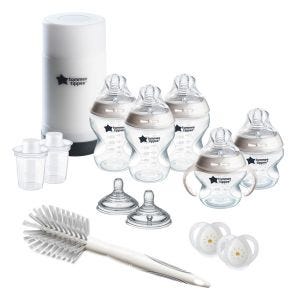
This is a demo store. No orders will be fulfilled.
Subscription orders can be cancelled at anytime. Free delivery on all subsequent subscription orders. Find out more about subscriptions.
They’re easy and fuss free
Your products are automatically sent to you
You save up to 10% when you sign up for a subscription
You can cancel at any time
We all know that safe sleep is very important for babies. But with so many different clothing options available, it can be difficult to know what your baby should wear to bed.
So, we've gathered all you need to know about baby sleepwear (and how to choose the right sleepwear based on the season and temperature) into one handy guide.
As your baby grows and develops, their sleepwear needs to evolve too! Keep on reading to learn about the different sleepwear styles available for each stage.
In general, it's good to dress your baby in clothes that you can easily remove with as little disturbance as possible. This will come in handy if they need to be changed during the night!
Swaddling younger babies using a purpose-built swaddle wrap or suit can keep them warm and help them sleep. It minimises/minimizes their Moro reflex (when their arms suddenly jerk up while asleep), and gives your baby a cosy, secure feeling that reminds them of being in the womb.
If you choose to use a blanket to swaddle your baby, it's critical to ensure that all loose ends are tucked in, so they can't choke or get tangled up.
Most babies should stop being swaddled by the time they start to roll over, or around two to six months.
Sleepbags are suitable for babies aged between six and 36 months. They're also a great alternative to swaddling once your mini-me has become a little more mobile. They can still feel safe, cosy, and secure with their legs tucked into their sleepbag, but with one or both of their arms free to stretch out.
Sleepsuits also keep your baby cosy and comfortable from six to 36 months but come with built-in legs and foot covers. This makes them perfect for little ones who have found their feet and want to toddle around before bed and when they wake up.
Small babies find it difficult to regulate their own body temperature like we can. Overheating can increase the risk of SIDS, so it's important that you make sure the tog of their sleepwear is appropriate for the temperature of their nursery throughout the year.
All our sleepwear styles come with tog ratings to help you know what your baby should be wearing in each season.
Tog ratings are a warmth scale. Think of them as a handy way for you to ensure that your baby is comfortable and safe as they sleep. Basically, the higher the tog rating, the warmer they will be, while a lower tog rating means they'll be cooler.
The pieces in our sleepwear range come in 3.5, 2.5, 1.0 and 0.2 tog
Remember, no matter the season or temperature, you should always check on your baby as they sleep to make sure they don't overheat. It's better for them to be cool than too hot.
The safest place for your baby to sleep is in the same room with you for the first six months. This will be especially helpful in judging the temperature they will be sleeping at.
The Lullaby Trust suggests feeling ���your baby's chest or the back of their neck (your baby's hands and feet will usually be cooler, which is normal). If your baby's skin is hot or sweaty, remove one or more layers of bedclothes.���
Signs a baby is too hot can include them:
Additionally, signs a baby is too cold can include:
If your baby shows signs of being significantly unwell, you should always seek medical advice.
Babies don't need to sleep in hot rooms and all-night heating is rarely needed. You should aim to keep the room at a safe temperature that feels comfortable - about 16 to 20��C or 60 to 68��F is perfect.
In the winter, you can dress your baby in sleepwear with a higher tog to keep them cosy/cozy. If your baby is too hot, their skin will be hot, slightly clammy or sweaty, and you'll need to remove some layers. If they're wearing a sleepbag in the correct tog, babies don't need to sleep under a duvet or quilt.
Even in the colder months of the year, most babies don't need to wear extra layers, even if they're unwell, and for safety they shouldn't ever sleep with a hot water bottle, electric blanket, next to a radiator, heater or fire, or in direct sunshine.
If your baby is sweating or their tummy feels hot to the touch, take off some of their sleeping layers. Don't worry if their hands or feet feel cool - this is normal.
It's important to remember that little ones lose excess heat through the tops of their heads, so their head shouldn't be covered while they're sleeping, and you should take off hats and extra clothing as soon as you come indoors or enter a warm car, bus or train.
If the room where your baby is sleeping is difficult to cool, use lighter tog clothing and open the bedroom door or crack a window, if it's safe to do so. You might also like to use a fan to cool the room, but don't aim it directly on the baby.
Finally, during the warm summer months, it's important to make sure your baby has plenty of fluids. Babies who're solely breastfed don't need any extra water until they start weaning, but if the weather is hot, they might want to breastfeed more. If your baby is bottle fed, you can give them some cooled boiled water to keep them hydrated alongside their usual milk.